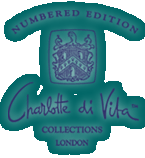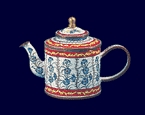| |

Inspired by The Connoisseur's Guide to
Christie's Collectible Teapots, this collection of six famous
teapots is for collectors with an appreciation of history.
In recognition of the Anglo-Sino
nature of our enamel programme, the first three teapots are minature
reproductions of Chinese teapots used in the Royal Household of
The Forbidden City in Beijing. As befitted a drink that was made
from precious leaves, then drunk in tiny bowls, teapots tended
to be smaller than those used today.
To complete the collection are three famous teapots selected by
Christie for their unique representation of teapots throughout
the 18th Century.
|
|

|
|
| |
New Products!


Teapot Collections:








|
|
|
|

|
|

|
|
 |
|
|
|
 |
 |
nbsp; |
Sèvres
Hard Paste |
EN585 |
 |
 |
 |
 |
|
|
|
|
Wemyss Ware
EN580
Made by Robert Heron and Sons at Fife in Scotland, the decoration
of this piece was by Karl Nekola, of Bohemia, who trained many
local men. Wemyss Ware sold extremely well, especially in London,
where its 'folksy' look became fashionable
with the upper classes. This particular teapot, dating from c.1900,
is painted in a fairly unusual manner, with bold brush strokes.
Pieces of Wemyss Ware decorated with flowers or fruits are most
collectable.
Sèvres hard paste EN585
In 1769 the famous French Sèvres factory was granted the
exclusive right to produce the first hard paste porcelain in France.
Since much of the early Sèvres porcelain was made for Royal
use, it was known as Royal Porcelain and a crown was added to
the usual marks. This teapot is in the Neoclassical style, which
replaced the Rococo in the mid-18th century.
Spode Caneware EN590
This Chinese style teapot, dating from c.1790, was made in caneware
and is enriched with blue and white enamels. Josiah Spode, a notable
Staffordshire potter established his famous English factory in
c.1770. Spode was best known for inventing porcelain that contained
bone ash, the world famous bone china.
|
|

|
|
| |
COPYRIGHT
INFORMATION Charlotte di Vita
and Trade plus Aid's designs are protected by design registration
and patent rights. All copyright, design right and other intellectual
property rights in our products, designs, trading names and in
the images, text and design of our website and brochures are and
remain the property of Charlotte di Vita, Trade plus Aid¨ or their
licensors. All IP rights are reserved worldwide, no reproduction
is allowed without written permission from Charlotte di Vita and
Trade plus Aid¨. Any infringement of these rights will be pursued
vigorously.
|
|